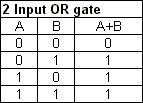I've attempted to answer the following question and I need to know if I am on the right track:
LOGIC GATES
Question 3
A manufacturing plant uses two tanks to store certain liquid chemicals that are required in a manufacturing process. Each tank has a sensor that detects when the chemical level drops to 25% of full. The sensors produce a HIGH level of 5V when the tanks are more than one-quarter full. When the volume of chemical in a tank drops to one-quarter full, or less, the sensor puts out a LOW level of 0V. It is required that a single green light-emitting diode (LED) on an indicator panel shows when both tanks are less than one quarter full.
3.1 Show the truth table
3.2 Derive the Boolean expressions.
3.3 Show how 3 NAND gates can be used to implement this
(Consider the wording very carefully in this question)
It's question 3.1 and 3.2. The last sentence of the main question is a bit tricky. It says "Show when both tanks are less than 1/4 full."
Here is my solution:
- Both inputs (namely Tank A and Tank B) need to be LOW in order to indicate a LOW output
- The only logic circuit to satisfy the above is an OR circuit.
- 0 + 0 = 0; 0 + 1 = 1; 1 + 0 = 1; 1 + 1 = 1
- From the above I believe OR operations is correct, since A and B are both LOW and thus causing the output to be low.
I was considering AND Circuit but then 0 x 1 = 0 and 1 x 0 = 0. These operations conflict with the question. The output must only show LOW when BOTH inputs are LOW.
Therefore my solution for 3.1 and 3.2 would be using an OR gate. Is that correct?



 .
.

